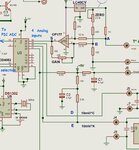hamid159
Full Member level 3
Hy guyz,i'm working on volt and ammeter.( 130V max. and about 40A )
Problem is that which parameter either voltage or current i connect to 'AN0' works fine.but the other parameter don't give constant value.i.e, fluctuating.first of all i connect the voltage to 'AN0' and worked fine.but current was varying on lcd.and then i connected the current (voltage across shunt ) to 'AN0'...satisfied.. but voltage was again altering...Here is code in C.
Problem is that which parameter either voltage or current i connect to 'AN0' works fine.but the other parameter don't give constant value.i.e, fluctuating.first of all i connect the voltage to 'AN0' and worked fine.but current was varying on lcd.and then i connected the current (voltage across shunt ) to 'AN0'...satisfied.. but voltage was again altering...Here is code in C.
Code C - [expand]
